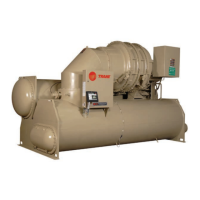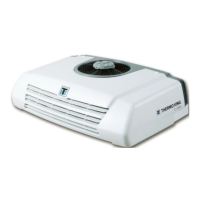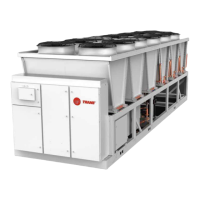Do you have a question about the Trane Technologies CVHE and is the answer not in the manual?
Manual covers these chiller models.
Control system details for the chillers.
Hazards of improper wiring.
Impact of chemicals on ozone layer.
Adherence to refrigerant handling laws.
Guidelines for refrigerant safety in equipment rooms.
Procedures for inspecting the unit upon arrival.
Regulations on waste handling.
Requirements for unit mounting surface.
Recommended methods for moving chillers.
Minimizing sound and vibration transmission.
Field-installed wiring requirements.
Installation of water piping circuits.
Rupture disc assembly and rupture guard.
Optional insulation for components.
Components for water pipe connections.
Materials for piping and testing.
Space needed for service and maintenance.
Conditions for proper operation of electrical components.
Requirements for chiller mounting surface.
Recommended methods for moving chillers.
Procedure for lifting standard units.
Specific lifting procedures and warnings.
Minimizing sound and vibration transmission.
Placement of isolation pads.
Considerations for spring isolator installation.
Procedures to ensure the chiller is level.
General information on water piping installation.
Importance of water treatment for unit longevity.
Guidelines for locating pressure gauge taps.
Installation of waterbox vents and drains.
Importance of strainers to prevent tube plugging.
Requirements for evaporator and condenser flow switches.
Installation of water temperature sensors.
Typical water piping arrangements.
Options for switching water box positions.
Typical evaporator and condenser water piping circuits.
Use of grooved pipe couplings.
Procedures for tightening flange bolts.
Guidelines for pressure testing the waterside piping.
Procedure for tightening water box covers.
Steps for installing the EarthWise purge system.
General recommendations for vent-line installation.
Compliance with ASHRAE Standard 15 for purge discharge.
Compatible materials for vent-line systems.
Sizing requirements for vent-lines.
Guidelines for constructing rupture disc vent lines.
Requirements for factory-installed insulation.
Insulation thickness for various components.
Power supply details for the UC800 controller.
Explanation of UC800 ports and wiring.
Supported communication interfaces for the UC800.
Use of rotary switches for address setting.
Behavior of UC800 LEDs.
Steps for installing the Tracer AdaptiView display.
Procedures for adjusting display arm tension.
General requirements for electrical installation and wiring.
Guidelines for electrical installation and service.
Safety equipment for electrical work.
Hazards and precautions for live electrical components.
Wiring requirements for Trane-supplied starters.
Wiring for customer-provided remote starters.
Sizing recommendations for CT and PT wires.
Requirements for proper field grounding.
Compatibility checks for 3-phase power.
Sizing of circuit breakers and disconnects.
Use of PFCCs for motor power factor correction.
Conduit layouts for starter and control panel wiring.
Use of terminal clamps for motor connections.
Field supply of wire terminal lugs.
Wiring remote starters to the compressor motor.
Installation of bus bars for motor terminals.
Wiring between starter and control panel.
Description and handling of the motor terminal box.
Requirements for motor supply wiring.
Procedure for connecting power wiring to motor terminals.
Connection of field ground wire to the lug.
Wiring for basic control functions.
Wiring for optional control features.
Low voltage circuit wiring.
Circuits for pump interlocks and flow switches.
Installation of temperature sensors.
Installation of optional control circuits.
Exchanging data with a Tracer system.
Overview of the initial unit start-up process.
Checking and configuring starter modules.
Location and availability of wiring drawings.
Basic operation and maintenance information.
Explanation of the cooling mode operation.
Operation of the 3-stage compressor.
Operation of the 2-stage compressor.
Description of the oil and refrigerant pump system.
Schematic and operation of the lubrication system.
Information tailored for operators and technicians.
Tool for accessing diagnostics and configuration.
Basic information on chiller operation for common events.
Generic states of the chiller software.
Explanation of the timeline cylinder and its indicators.
Step-by-step start-up sequence for Wye-Delta starters.
Tracer AdaptiView screens during processor power up.
Diagram of the five possible software states.
Feature for ice building mode operation.
Adapting the chiller as a simple heat exchanger.
Steps to enable and disable the Free Cooling mode.
Option to minimize cycling under minimum load.
Using the chiller as a heating source.
Salvaging heat for beneficial use.
Location of safety and operating controls.
Reducing pump energy consumption.
Displaying text in multiple languages.
Overview of start-up and shut-down processes.
Preliminary checks before unit start-up.
Procedure for daily unit shutdown.
Procedures for seasonal shutdown.
Procedures for starting the unit after seasonal shutdown.
Daily checks for proper operation.
Importance of completing maintenance records.
Recommended intervals for maintenance procedures.
Procedure for changing compressor oil and filter.
When and how to replace the oil filter.
Periodic lubrication of specific components.
Maintenance for tang operators on 1st stage.
Maintenance for extended capacity chillers.
Methods for cleaning condenser tubes.
Recommended cleaning frequency for evaporators.
Function and operation of the EarthWise Purge system.
Calculating leakage rate from purge pump out time.
Extended storage requirements for chillers.
Steps to prepare a unit for storage.
Procedure for charging refrigerant.
Connections for refrigerant removal and replacement.
Methods for leak testing the chiller.
Overview of waterbox removal and rigging.
Steps for removing and installing waterboxes.
Steps for reinstalling waterboxes after service.
Checklist for pre-commissioning and installation observations.
Steps for preparing the unit before start-up.
Checks for motor starter panel and control panel.
Steps for evacuation, charging, and electrical checks.
Procedures for starting the chiller unit.
Operator training on starting, operating, and shutting down.
Manual covers these chiller models.
Control system details for the chillers.
Hazards of improper wiring.
Impact of chemicals on ozone layer.
Adherence to refrigerant handling laws.
Guidelines for refrigerant safety in equipment rooms.
Procedures for inspecting the unit upon arrival.
Regulations on waste handling.
Requirements for unit mounting surface.
Recommended methods for moving chillers.
Minimizing sound and vibration transmission.
Field-installed wiring requirements.
Installation of water piping circuits.
Rupture disc assembly and rupture guard.
Optional insulation for components.
Components for water pipe connections.
Materials for piping and testing.
Space needed for service and maintenance.
Conditions for proper operation of electrical components.
Requirements for chiller mounting surface.
Recommended methods for moving chillers.
Procedure for lifting standard units.
Specific lifting procedures and warnings.
Minimizing sound and vibration transmission.
Placement of isolation pads.
Considerations for spring isolator installation.
Procedures to ensure the chiller is level.
General information on water piping installation.
Importance of water treatment for unit longevity.
Guidelines for locating pressure gauge taps.
Installation of waterbox vents and drains.
Importance of strainers to prevent tube plugging.
Requirements for evaporator and condenser flow switches.
Installation of water temperature sensors.
Typical water piping arrangements.
Options for switching water box positions.
Typical evaporator and condenser water piping circuits.
Use of grooved pipe couplings.
Procedures for tightening flange bolts.
Guidelines for pressure testing the waterside piping.
Procedure for tightening water box covers.
Steps for installing the EarthWise purge system.
General recommendations for vent-line installation.
Compliance with ASHRAE Standard 15 for purge discharge.
Compatible materials for vent-line systems.
Sizing requirements for vent-lines.
Guidelines for constructing rupture disc vent lines.
Requirements for factory-installed insulation.
Insulation thickness for various components.
Power supply details for the UC800 controller.
Explanation of UC800 ports and wiring.
Supported communication interfaces for the UC800.
Use of rotary switches for address setting.
Behavior of UC800 LEDs.
Steps for installing the Tracer AdaptiView display.
Procedures for adjusting display arm tension.
General requirements for electrical installation and wiring.
Guidelines for electrical installation and service.
Safety equipment for electrical work.
Hazards and precautions for live electrical components.
Wiring requirements for Trane-supplied starters.
Wiring for customer-provided remote starters.
Sizing recommendations for CT and PT wires.
Requirements for proper field grounding.
Compatibility checks for 3-phase power.
Sizing of circuit breakers and disconnects.
Use of PFCCs for motor power factor correction.
Conduit layouts for starter and control panel wiring.
Use of terminal clamps for motor connections.
Field supply of wire terminal lugs.
Wiring remote starters to the compressor motor.
Installation of bus bars for motor terminals.
Wiring between starter and control panel.
Description and handling of the motor terminal box.
Requirements for motor supply wiring.
Procedure for connecting power wiring to motor terminals.
Connection of field ground wire to the lug.
Wiring for basic control functions.
Wiring for optional control features.
Low voltage circuit wiring.
Circuits for pump interlocks and flow switches.
Installation of temperature sensors.
Installation of optional control circuits.
Exchanging data with a Tracer system.
Overview of the initial unit start-up process.
Checking and configuring starter modules.
Location and availability of wiring drawings.
Basic operation and maintenance information.
Explanation of the cooling mode operation.
Operation of the 3-stage compressor.
Operation of the 2-stage compressor.
Description of the oil and refrigerant pump system.
Schematic and operation of the lubrication system.
Information tailored for operators and technicians.
Tool for accessing diagnostics and configuration.
Basic information on chiller operation for common events.
Generic states of the chiller software.
Explanation of the timeline cylinder and its indicators.
Step-by-step start-up sequence for Wye-Delta starters.
Tracer AdaptiView screens during processor power up.
Diagram of the five possible software states.
Feature for ice building mode operation.
Adapting the chiller as a simple heat exchanger.
Steps to enable and disable the Free Cooling mode.
Option to minimize cycling under minimum load.
Using the chiller as a heating source.
Salvaging heat for beneficial use.
Location of safety and operating controls.
Reducing pump energy consumption.
Displaying text in multiple languages.
Overview of start-up and shut-down processes.
Preliminary checks before unit start-up.
Procedure for daily unit shutdown.
Procedures for seasonal shutdown.
Procedures for starting the unit after seasonal shutdown.
Daily checks for proper operation.
Importance of completing maintenance records.
Recommended intervals for maintenance procedures.
Procedure for changing compressor oil and filter.
When and how to replace the oil filter.
Periodic lubrication of specific components.
Maintenance for tang operators on 1st stage.
Maintenance for extended capacity chillers.
Methods for cleaning condenser tubes.
Recommended cleaning frequency for evaporators.
Function and operation of the EarthWise Purge system.
Calculating leakage rate from purge pump out time.
Extended storage requirements for chillers.
Steps to prepare a unit for storage.
Procedure for charging refrigerant.
Connections for refrigerant removal and replacement.
Methods for leak testing the chiller.
Overview of waterbox removal and rigging.
Steps for removing and installing waterboxes.
Steps for reinstalling waterboxes after service.
Checklist for pre-commissioning and installation observations.
Steps for preparing the unit before start-up.
Checks for motor starter panel and control panel.
Steps for evacuation, charging, and electrical checks.
Procedures for starting the chiller unit.
Operator training on starting, operating, and shutting down.
| Brand | Trane Technologies |
|---|---|
| Model | CVHE |
| Category | Chiller |
| Language | English |



